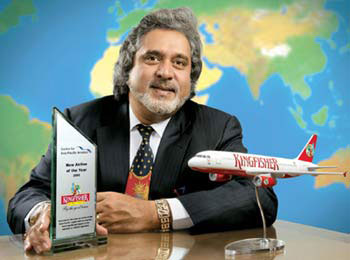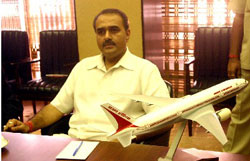

 |
 |
|
| |
||
|
| The government of India
led by Prime Minister Manmohan Singh has taken the first definite step to
boost the air cargo sector. Airfreight stalwarts have been inducted in the
recently formed core group on aviation. Their presence would at least ensure that the sector’s views are heard by the powers-that-be. It is, indeed a step in the right direction. For long, the air cargo sector has been relegated to the background even as the passenger sector holds on to the limelight. This despite the fact that civil aviation in the country continues to hog the headlines. If it is not airport modernization, there are stories on low-cost carriers, greenfield airports, infrastructure, and what have you. India has seen an astounding growth in airfreight services. Air cargo has steadily risen from 4.16 lakh tons in 1998-99 to 4.91 lakh tons in 2000-01, 5.84 lakh tons in 2003-04 and over 6.20 lakh tons during the last fiscal year. Those numbers translate to increase of 11.9 per cent between March and December 2005, while international cargo witnessed a jump of 4.1 per cent during the same period. The burgeoning trade in garments, machinery, components, pharmaceuticals, dyes, chemicals and perishables such as fruit, vegetables, flowers, fish and meat, has witnessed existing airlines and even the new ones on the block cashing in on the boom. However, what has held back the growth is inadequate airport infrastructure. That has been stifling the growth in air cargo traffic vis-à-vis the potential available. In a recent presentation, Dr K Ramalingam, chairman of Airports Authority of India (AAI), mentioned the potential: AAI had the capacity to handle 15 lakh metric tons (MT) of international cargo at the four metro airports -- Chennai, Delhi, Kolkata and Mumbai against the 8.86 lakh MT handled in 2004-05. That was indication enough that sufficient capacity was available at the metro airports. “Cargo doesn’t speak. “Hence it is ignored at airports.” Dispelling such a notion, Dr Ramalingam had pointed out that the authorities were aware of the growing need for infrastructure development as far as cargo handling was concerned. He was not alone. Werner Schuessler, senior vice-president, production, Lufthansa Cargo AG, for example, has been closely watching India and China for quite some time. He told FlyingTypers: “There are three things that a country needs to progress: Infrastructure, Infrastructure and Infrastructure.” Schuessler could not be more direct. Infrastructure at airports or rather the lack of it “has not deterred the air cargo sector from growing.” Said Cyrus Katgara, one of India’s leading freight forwarders: “Too much has been said in the past about the lack of infrastructure at the airports. “Now we need no compromises. “What we must have is international standard airports with air cargo facilities.” Many say the sooner the better.  Dr.
Vijay Mallya, Chairman and Managing Director, Kingfisher Airlines Limited
proudly displays ‘Best New Airline Of The Year’ CAPA Award for
2005. Kingfisher Airlines recently placed an order for 30 Airbus A320 aircraft
at the Dubai Air Show 2005 in a deal valued at US $1.9 billion, which follows
its purchase of 20 ATR 72-500 Turboprop Aircraft valued at US $ 350 million. Dr.
Vijay Mallya, Chairman and Managing Director, Kingfisher Airlines Limited
proudly displays ‘Best New Airline Of The Year’ CAPA Award for
2005. Kingfisher Airlines recently placed an order for 30 Airbus A320 aircraft
at the Dubai Air Show 2005 in a deal valued at US $1.9 billion, which follows
its purchase of 20 ATR 72-500 Turboprop Aircraft valued at US $ 350 million.
Kingfisher Airlines is also the first Indian carrier to have placed an order for five Airbus A380s, five A350s and five A330s. The deliveries of A330s are expected to begin in 2007 while the A380s and A350s arrive in 2010 and 2012 respectively. India's low-cost carrier Go Air ordered 20 Airbus 320s at Asian Aerospace in Singapore last month for $1.2 billion while Spice Jet ordered ten Boeings for 700 million, after state-run Indian Airlines (Indian) ordered 43 Airbuses at $2.5 billion. Not to be outdone Air India spent $2 billion order for GE engines Asian Aerospace. In total Indian firms placed orders for $6.5 billion at the show. Worth noting is that during 2004-05 alone, Indian carriers ordered close to 400 planes, accounting for almost 30 percent of all new aircraft orders booked. Indian Airlines will reportedly convert some of its current fleet into freighters over time. Jet Airways, GoAir and Kingfisher Airlines have chalked out plans to play a bigger role in the airfreight market. Scheduled for a summer launch is First Wings, the air cargo arm of India’s First Flight Couriers Private Limited (FFCL). Air India after discontinuing its loss-making freighter service in the mid-90s now has plans to make a major re-entry in the air cargo segment. Currently a marginal player in the cargo business with only 7-8 per cent share of the air cargo market in the country, in 2004-05, Air India generated revenues of Rs 500 crore (from its cargo business), representing 10 per cent of the total revenues. |
The airline hopes to raise
cargo revenues to 15-20 per cent of the total in three to four years. Air India has decided to convert aircraft into full-fledged cargo carriers. In addition, it will also look at leasing freighters. The airline will utilize the Boeing 747-400 for long-haul routes while three A310 aircraft will be used for handling the short and feeder routes. Air India has leased belly space on Falcon Aviation to meet the demand generated on the Kerala-Gulf and the India-Europe sectors. Additionally, two of its A310 aircraft are scheduled for conversion into freighter aircraft by September 2007. When the airline takes delivery of its new fleet in the last quarter of 2006, it will enhance its cargo capacity. It is not merely Air India or Indian (Airlines) that is interested in air cargo.  The
newest airline in the Indian skies, 31-year-old Jeh Wadia’s (pictured
left) GoAir has chalked out big plans, too. The
newest airline in the Indian skies, 31-year-old Jeh Wadia’s (pictured
left) GoAir has chalked out big plans, too. The airline is believed to have finalized its strategy. Wadia was quoted as saying that GoAir would commoditize its business. Aircraft manufacturer Boeing has estimated that India’s domestic air freight market this year could go up to more than the 2.25 lakh tons it hit in 2005. In fact, a recent study by Drewry and APL Logistics has stated that India's air cargo traffic could be expected to register annual gains in the 8 to 10 per cent range over the next 10 years or so. As the report said: "Clearly, this is good news for the airline service providers, which are now seeing more return cargo, a fact that will help the overall market to grow". The growth in airfreight in the country has far outstripped international airfreight traffic growth (3.2 per cent in 2005). The end-of-year (2005) report by the International Air Transport Association (IATA) stated that air freight shipping in some of the world's largest markets was virtually stagnant last year, with North America business up only 0.4 per cent over 2004 and Europe's traffic up 1.1 per cent. Even the Asia-Pacific region, where exports from China have pumped up trade with Europe and the United States, grew only 4.2 per cent in 2005, far slower than the rate of capacity growth and well behind forecasts for expansion in the region. The pace of growth accelerated at the end of the year, with double-digit gains in the Middle East and Latin America, pushed the global airfreight business up 5.5 per cent in December over the same month the year before. But even as the North America picked up steam, growing 4.2 per cent in December, international airfreight for European carriers edged up only 0.8 per cent over December 2004.  To
facilitate and promote the growth of airfreight, Indian civil aviation minister
Praful Patel formed a Core Group on Civil Aviation. Meant specifically to
address issues related to aviation, the core group has attracted the attention
of the air cargo industry. To
facilitate and promote the growth of airfreight, Indian civil aviation minister
Praful Patel formed a Core Group on Civil Aviation. Meant specifically to
address issues related to aviation, the core group has attracted the attention
of the air cargo industry. Senior members of the air cargo industry, who have been inducted into the group feel that the forum could be the perfect platform to highlight the problems faced by the industry. The first meeting is likely to be convened in the near future, at which time the terms of reference/scope of work would emerge. The importance that the civil aviation minister attaches to the air cargo industry can be gauged from the fact that members of the air cargo industry have been made part of the core group. The air cargo sector feels that some of the areas that it would like to use this forum to delve into could include: • Developing India as a regional air cargo hub (international gateways, cargo villages, forwarders' bonded air cargo terminals). • Air Capacity • Technology in cargo handling. • EDI in air cargo • Meeting trade / customer needs (logistics costs, simplified processes, transit time) • Government monopolies • Process improvement - performance parameters • Monitoring performance • Aviation security • Industry professionalism and training (Tirthankar Ghosh) |